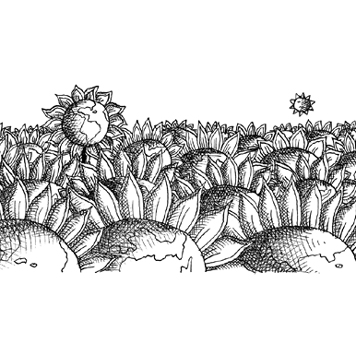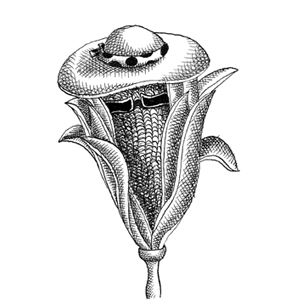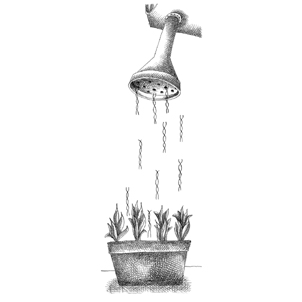01-05-2004
Plants are necessary for the continuation of life on Earth: they form a key link in the food chain, supply energy, and enrich the air with oxygen. Research conducted at the Weizmann Institute helps protect the planet’s plant life from potentially detrimental changes in the environment. Another line of plant research at the Institute is aimed at making farming more environmentally safe. Farming is vital for our survival, but it is also one of the most destructive human activities: it contributes to water pollution, soil erosion, and ecological imbalance. Weizmann Institute researchers are developing ways to enhance crop yields while reducing the amount of harmful chemicals used in agriculture.
Plant “Sunscreen”
The hole in Earth’s sunscreen - the ozone layer - may be responsible for the recent rise in ultraviolet (UV) radiation reaching our planet. In humans, this disturbing phenomenon already appears to have increased the incidence of skin cancer. Weizmann Institute research suggests that agricultural crops, too, may be adversely affected.
Prof. Meir Edelman of the Plant Sciences Department studies the responses of the plant’s energy-producing unit, the photosynthetic reaction center, to increased ultraviolet radiation. Plants have developed a variety of defenses against the potentially damaging UV light. Wax on the surface of leaves, for example, scatters UV light to protect the cells’ contents; chlorophyll molecules absorb the harmful rays; and the photosynthetic reaction center constantly replaces part of its machinery, which apparently gets worn out by excessive UV exposure.
Edelman discovered, however, that a crucial component of the reaction center, called d2, normally fails to undergo significant recycling. This component is especially vulnerable to increments of UV-B radiation when UV-B light is combined with visible light - as is the case with ordinary sunlight. In other words, if the amount of UV-B rays in the atmosphere increases in the future, the core of photosynthesis could suffer. By experimenting with strains of soybeans that have elevated tolerance to UV-B radiation, Edelman, in collaboration with Dr. Autar Mattoo of the U.S. Department of Agriculture, is trying to determine how such damage could affect crops. This research may help protect essential crops from the danger of excessive UV-B radiation - perhaps through the use of light-absorbing greenhouse plastics or the genetic engineering of resistant plants.
Gene Therapy for Plants
About 20 percent of worldwide crop yields are lost to pests and disease, and millions of acres are ravaged by a host of bacteria, viruses, and fungi. To reduce the damage, farmers spray their fields with strong and often nasty chemicals. For instance, effective protection of plants against fungal attacks includes treatment with environmentally hazardous bromides. New scientific approaches may enable plants to fight disease on their own, without relying excessively on chemicals.
Prof. Robert Fluhr of the Weizmann Institute’s Plant Sciences Department, seeks to understand how plants protect themselves against disease. He has discovered genes that provide wild plants with disease resistance. Using methods enhanced by genetic engineering, he and his team are transferring these genes into crops. This research may significantly decrease the amount of harmful sprays used in agriculture.
Prof. Fluhr focuses mainly on Israel’s favorite vegetable, the tomato. He has identified genes that make wild tomatoes resistant to wilt disease, which is caused by the penetration of a fungus called fusarium. The fungus robs the plant of food and secretes poisons that cause plant cells to die, until the entire plant wilts. Fluhr identified the gene responsible for protecting wild tomatoes from wilt disease. When he reintroduced the resistance gene into cultivated tomatoes, the genetically engineered plants became resistant to disease. The gene therapy for tomatoes worked! In the past, farmers bred resistance into cultivated plants on the basis of intuition, but now Weizmann Institute research has given them a tool for performing this task with greater precision.
Fluhr has demonstrated that the tomato’s natural defense mechanism against fungal disease works in two main stages. The first is based on an “intelligence unit” that identifies the invading fungus and notifies the plant; in the second stage, the defense system secretes substances that destroy the fungus or prevent its encroachment. Fluhr’s group is trying to understand how the signals about fungal invasion are sent and received, and is developing ways to mimic these “intelligence” agents. This research could lead to the development of strategies that would enable the farmers of the future to prevent diseases in their crops by signaling the plants’ “immune systems” to defend the plant’s cells.
Weeding Out Hunger
Darwinian competition applies in the world of plants just as it does in the animal kingdom: survival goes to the fittest. Weeds are easily ahead of crops in this battle: they wouldn’t be weeds if they weren’t experts on survival. Therefore, conquering weeds - the oldest problem in agriculture - requires enormous efforts, often involving damage to the environment. Now science offers more environmentally friendly solutions.
Prof. Jonathan Gressel of the Weizmann Institute’s Plant Sciences Department seeks to weed out hunger using genetic engineering. He is developing scientific strategies for battling weeds that can boost crop yields while avoiding environmental devastation. The impact of these studies can be particularly dramatic in developing countries, many of which are plagued by food shortages. Gressel has devised several strategies for eliminating two root-attacking parasitic weeds - broomrape and witchweed - that halve the yields of 100 million farmers in Africa.
One strategy is to endow crops with genes coding for herbicide resistance, then to treat the seeds with herbicide before planting. The resistance gives crops an advantage over their unprotected weed neighbors when farmers spray entire fields with herbicides. The approach allows farmers to treat the seeds with minuscule amounts of herbicides and to opt for ecologically sound chemicals. Better chemicals, in turn, reduce the need for land cultivation, by hand or tractor, which translates into less soil erosion and less fuel burned to run tractors, and prevents encroachment on lands allotted for wildlife reserves. The transferring and stabilizing of the genetic inserts into indigenous corn varieties, undertaken by CIMMYT - the Spanish acronym for the International Maize and Wheat Improvement Center - took a number of years, and the first large-scale, multi-farmer trials are currently under way throughout eastern Africa.
This approach enables farmers to benefit from the latest scientific advances while retaining traditional farming techniques. Kenyan farmers like to plant alternating rows of corn and beans in the same field, but spraying the entire field with herbicides presents a problem: while one crop may be resistant to the herbicide, the second crop may be killed by the spraying. The need for spraying, however, can be eliminated by soaking the seeds: once the seeds sprout, the parasites are killed by unwittingly devouring the weed-killing chemical in the crop roots or surrounding soil. In experiments in Kenya, performed in collaboration with CIMMYT, crop yields tripled thanks to this approach.
In another strategy that helps farmers be less dependent on chemical sprays, Gressel’s group is recruiting traditional plant enemies, such as a specific fungus that attacks broomrape but does not affect any known crops. By using the fungus, the scientists are developing a weapon that will attack the weed in the ground before it does damage. The researchers are genetically engineering the “biocontrol” fungus to enhance its virulence and render it no less effective than chemicals. (Special measures are taken to preclude the movement of the virulent genes from useful fungi to disease-causing organisms.) In yet another approach, Gressel’s team is genetically engineering plants to increase their resistance to drought, enabling crops to compete with weeds for small amounts of water.
However, giving plants genetic advantages poses risks - among them, the danger of producing “superweeds.” In a phenomenon known as gene flow, DNA traveling on pollen passes naturally between closely related plant species. Normally, gene flow helps plants evolve; but if crops share their genetic secrets with the surrounding weeds, the process can lead to the emergence of hard-to-kill weeds. Gressel’s group is developing ways to hide genetic “booby traps” for the weeds alongside the genes that benefit varieties of wheat and canola. The booby trap gene, while not affecting the crop, would be designed to harm the weeds in the event that the advantageous gene is passed on.
The Odor of Control
Farmers around the world have reason to be alarmed: a highly effective soil fumigant used to control insects and other pests has been identified as a chemical that contributes to the depletion of the Earth’s ozone layer. By 2005, methyl bromide is supposed to be phased out in developed countries; viable alternatives must be found for its various uses by that time. Apart from being used to sterilize soil before planting, the substance is employed to control pests during the storage and shipment of grapes, raisins, cherries, nuts, and other commodities; to disinfect such structures as food processing plants and warehouses; and to fumigate exported agricultural products as required by receiving countries - including apples and cherries shipped to Japan, oak logs shipped to Europe, and strawberries shipped to Australia.
Weizmann Institute scientists have proposed a pungent-smelling but effective and environmentally friendly alternative to methyl bromide in one major application. They suggest that allicin, the main biologically active ingredient of garlic and the one responsible for its smell, can be used to dinsinfect soil. Until recently, allicin’s uses have been limited by the fact that it is highly unstable. However, Weizmann researchers Drs. Aharon Rabinkov and Talia Miron and Profs. David Mirelman and Meir Wilchek have designed a biotechnological method for producing large quantities of stable allicin. Using their semi-synthetic product, the scientists have shown that allicin effectively destroys pests in the soil when it is dripped into the irrigation system. These studies were conducted in collaboration with microbiologist Prof. Ilan Chet, then working at the Hebrew University of Jerusalem and now President of the Weizmann Institute. In nature, allicin protects the garlic plant from soil parasites and fungi. If this natural protection system were employed on an industrial scale, the need for environmentally hazardous pesticides like methyl bromide might be sharply reduced.
Cellular Crisis Management
Unlike animals, plants cannot hide in the shade on a sunny day or roam about looking for water during a drought. Instead, they rely on internal emergency mechanisms that detect changes in the environment and help them live through hard times. The plants may stop growing, wilt or sag, but their built-in emergency kit often allows them to survive disaster at least for a while. By unraveling these crisis management strategies, scientists may be able to develop tougher crops that would grow under harsh conditions.
Prof. Gad Galili of the Plant Sciences Department studies processes that allow plant cells to cope with stress. He is focusing on the secretory pathway, a cascade of mechanisms by which various compounds are transported throughout the cell. It’s a busy highway: not only are plant cells constantly breaking down and recycling their parts, but new proteins must be delivered to appropriate targets to keep the cells in top shape. When a plant is starving or comes under attack, this cellular delivery system switches into overdrive, breaking down existing proteins and building such crucial components as energy enzymes and trafficking proteins. (Human cells do this too, but plants have developed more versatile mechanisms for this purpose.)
Galili’s research could yield important environmental and agricultural rewards. A better grasp of how plant cells react in a crisis could help farmers develop more emergency-ready crops. It could also lead to the development of more protein-rich crops, which in turn might reduce the Western world’s dependence on meat and alleviate malnutrition in developing countries.
Early Achievements
Plant research, one of the earliest fields of study at the Weizmann Institute, has led to the development of numerous crops having increased yields and improved resistance to plant diseases, grown today in Israel and elsewhere. Agricultural success stories derived from past Institute research include disease-resistant Delilah cucumbers, the first ever commercial hybrid cucumber; early-ripening melons; protein-enriched wheat with significantly higher yields; and castor bean plants with an increased bean-per-plant ratio, valued for the industrial oils extracted from the bean. Such crops can reduce the amount of farming needed and allow farmers to reduce field spraying - a telling example of basic plant science serving human needs.
Prof. Avraham Levy of the Plant Sciences Department has adapted a miniature tomato plant for unraveling the genetic code of plants. He has equipped the Micro-Tom tomato with “jumping genes,” also known as transposons, which move spontaneously around the plant’s genome and insert themselves into the genetic code. Transposon “jumping” can be used to clarify the function of already deciphered genes. In fact, several potentially useful genes, which may help develop plants capable of fighting pollutants or thriving in a salty environment, have already been identified using this method. In the future, Micro-Tom may be used to identify the genetic sequences that encode other useful traits.


